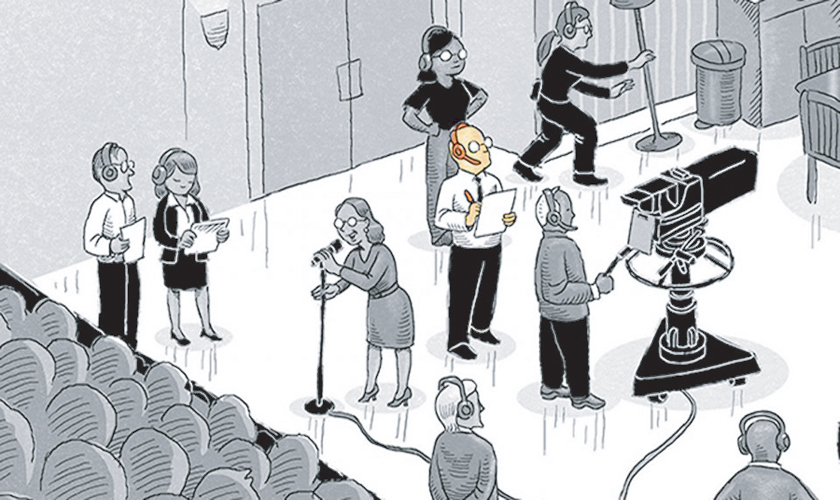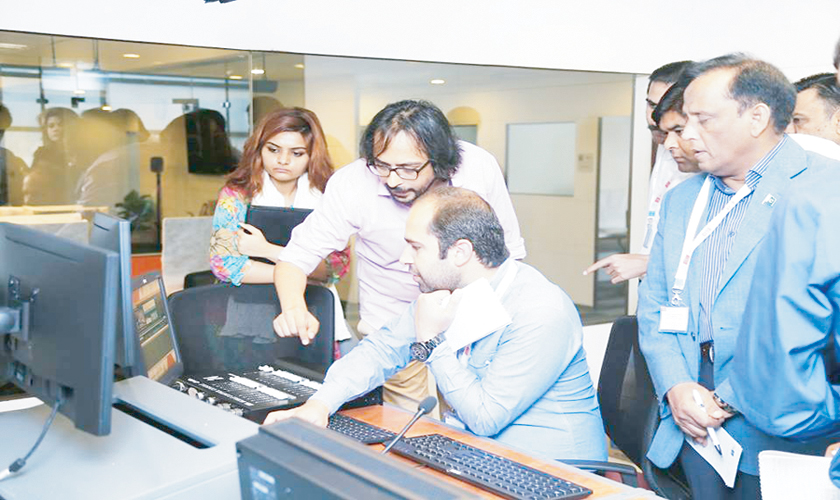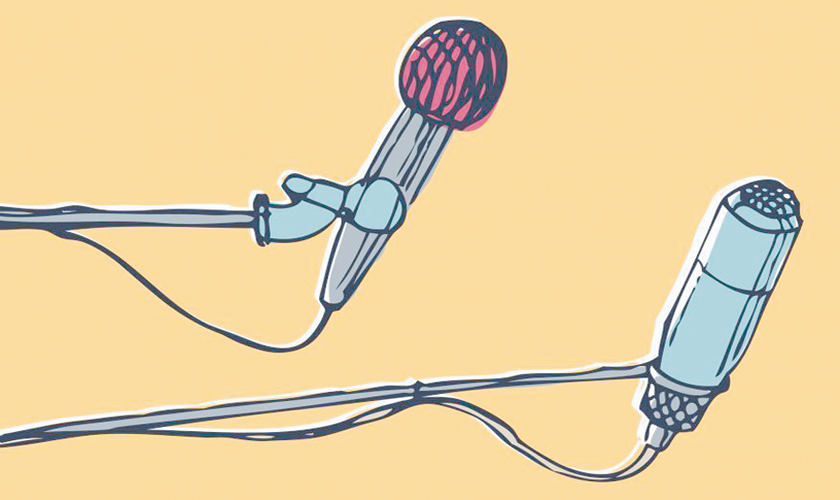The business behind a show
Solid images. A powerful voice accompanying them. An informative topic. That’s what keeps me from changing the channel on TV. Not just any programme; but a proper talk show.

But my definition of “proper” was not complete as I learned in the two-week course held at CEJ-IBA (Centre for Excellence in Journalism, Institute of Business Administration). With trainers, Faisal Sayani, a freelance journalist, independent filmmaker and Karachi-based producer, and Gary Pierre-Pierre, a Pulitzer Prize-winning, multi-media and entrepreneurial journalist, host and senior producer, however, this was set to change. It seems there is a lot to producing one such show than what meets the eye. It’s not simply going live to report what’s new. You are literally influencing public opinion. Then, you also have to be careful about the technical execution of the show in addition to the editorial component.
Here I would like to mention what one person, in sheer ignorance, asked my colleague regarding this programme. In her humble opinion, a journalist such as myself working for youth magazine had nothing to do with a production course. She was curious if I had left the desk and switched to electronic media!

For starters, choosing a topic, working on how to present this content, doing your homework on who to talk to and how are pretty much the same. I mean, there is a specific subject you’d be dealing with in one article/show. Sure, you may have more liberty to polish a piece while writing, but the point remains you are equally responsible while reporting for both mediums. The time that goes into researching a topic, finding an angle not discussed before - it’s the same even if the show’s/magazine’s policies vary according to the audiences they cater and the rating competition they’re part of. The rules of interview then follow: you get to decide who’s the best person/organization to approach for the said discussion, the type of questions you’ll ask, improvising and formulating follow-up questions from what they say, how much time you’ll give them, to interrupt or not to interrupt them; facilitate them, basically. Even the graphics you want to use are something you’d consider when preparing for either. There’s no rule and yet you plan the same way; you allow yourself to be creative; you want to create an impact.
So, you begin by answering what people want; what message or solution would struck a chord with them. In journalism, you’re responsible to the audience; you shouldn’t wait for a person or a regulatory body to criticize your work and see you toed the line. Define your own limits and then police yourself.
As Mr. Kamal Siddiqi, journalist and teacher, was quick to point out in his session on ethics there’s no legal implication if one breaks them.
Perhaps, it’s because a number of journalists these days are self-taught. Or because it’s all about money now that the media groups are ready to compromise and give in to the whims of the advertisers.
That said, there’s obviously a lot that is different between what goes on air and what’s printed.

In an ideal world, you’d have a week to think of a good story and follow it. In reality, you may have as much as half an hour to prepare! In the two-week course, we were not only grasping the basics of TV production, but were also asked to pitch ideas for a show, to finalize content, to collect visuals, to reach out to guest(s), and of course shoot the segments. And here’s what I learned.
“I just arrive, they hand me a script and say, ‘Do it!’”
That’s not always true for a TV show. You can have notes to not forget the important details, but often when you are interviewing the guest, you have to be ready to abandon all your questions and to pick up from what he/she is saying in front of you. Yes it’s good to stick to your topic, but then it also happens that what the other person is saying might be more interesting to your audience.
The current affairs and breaking news dilemma
Not something our TV channels consider, but should. Just because a competitor is doing it is not a good enough reason to ride with the tide and drop everything else. Does it have anything to do with your show? Not your channel; your show. Let the other programmes that run on the channel 24/7 cover it. This way you maintain your credibility.
Guest selection is crucial
If the anchor knows more than their guest, then there is actually no need for that guest to be on the show! Pakistani talkshows usually bring someone who passes away the time, offering little (if any) knowledge, going back and forth engaged in ‘discussion’ or an open brawl!
Of course, you need to be aware of the topic if you are to go with whatever happens in the show, and also because you cannot rely on good camerawork for face-saving with a weak content in tow. Conflict is good, too. But these shows are more of a conversation between the parties and should be treated as such.
Looks matter - but so do manners!
I remember the girl who was reluctant in going out for the camera exercise with her group. Her fear: the Karachi sun would give her a real bad tan and being the anchor she couldn’t afford that. To appear well-groomed is especially important for those appearing on-screen; something that can be overlooked when recording for radio or a magazine article. (How else could I have enjoyed interviews over Skype in my PJs, messy bun and snacks right next to my phone cum recorder?) Besides this, other factors like your tone and your body language matter as well as the comfort level of your guest. You have to choose your words carefully, but for TV the impact comes from the visuals.
Not a one man show
“You can’t be alone. To really succeed, no man really is an island. When you find the right components in your life, the right people [who] gel with you, then you feel as though you’re invincible.”
Know the feeling? One point that was clear from the beginning was that TV production is supposed to be a group work. You’d have to coordinate with each other, pay heed to instructions whether on-set or on-field in order to pull off the show creatively and technically. And who makes it to the team? Scriptwriter, camera operator, reporter, researcher, editor, producer and director to name a few. For people who were already part of the TV fraternity, this was an opportunity to advance their practical TV production skills. Translation: learning to be really firm; learning to check the equipment before going live; to seeing each shot is at least five to 10s long so the editor has space when given the footage.
Take four: Edhi after Edhi
Out of all our (Team Four) pitches, the one that got selected was on Edhi Foundation and how it is functioning after Abdul Sattar Edhi’s death. So much had already been aired and written about the legendary philanthropist; our aim was to see if the organization had met with any difficulties owing to the fact that they are receiving fewer donations for these past couple of months. We asked people outside IBA whether they think Edhi Foundation’s running as smoothly as it used to and what they think were the reasons for the decline in funding.
Amidst hunger pangs and selfies, our group talked to the people directly affected by the shift in administration and accusations of ill use of their money: women and children living in Edhi homes. Notwithstanding homesickness, each of them appeared to be content with the level of care extended to them. As Bilquis Edhi was out of town, we only had Faisal Edhi as our guest, that too in his office and not the studio. It meant only one thing: position the camera onto the tripod, check if it had a fully-charged battery and its memory card, figure out the angle and set white balance for the shot, zoom in on the subject and set focus. Since we were in his office, we had to be extra careful that no extra sound was being recorded. Using a single baby light did not benefit us in the dimly-lit, windowless room but neither did resorting to completely opening the aperture helped since the shots then taken were somewhat blurry. The next day, the whole team trooped in production control room while the two leaders were hosts in the studio; their exchange was recorded. And then it was over to the editor. A quite impressive voice-over was given at the last moment; I was in awe how passionately a person can speak when the cause is close to their heart. Needless to say, the whole thing was rushed. We were surprised when the instructor started clapping after seeing the clip and terming it the best he had seen that day.
According to the Society of Professional Journalists, the code of ethics (“voluntarily embraced by thousands of journalists, regardless of place or platform”) is divided into four parts:
1. Seek truth and report it (Journalists should be honest, fair and courageous in gathering, reporting and interpreting information)
2. Minimize harm (Journalists treat sources, subjects and colleagues as human beings deserving of respect)
3. Act independently (Journalists should be free of obligation to any interest other than the public’s right to know)
4. Be accountable (Journalists are accountable to their readers, listeners, viewers and each other)
Tip #1
Silence during interviews can be used for emphasis when the guest is not providing any answer. It can be a useful tool to put them in an awkward position and say more than they meant to.
Camera hacks 101
Tip #2
Article 19A of The Constitution of Pakistan states:
“Every citizen shall have the right to have access to information in all matters of public importance subject to regulation and reasonable restrictions imposed by law.”
Thus established that each and every citizen has the right to information (RTI) and record held by public bodies, subject to restrictions. Freedom of information (FOI) denotes a situation in which Pakistani citizens can easily ask for and receive any information from the public bodies (including government and semi-government departments).
Tip #3
There are two types of people you’ll come across: (1) those who have something to say and don’t want to talk; (2) those who don’t know anything and want to talk.
Your job is to convince the former to talk to you since they are usually the relevant person for the topic. Don’t try the guilt-approach with them; instead, flatter them. Tell them the topic and why you/your team chose it; tell them you think they’re the best person for it and without them, you won’t be able to do justice to the topic.
Given your credibility as a journalist, another scenario is when a person tells you they want to come on your show. You must identify the issues beforehand, research and have at least 10 questions ready for each issue. Also have some backup questions ready - if the guests say this, then I’ll ask them this question.
And no matter what, be in control of the direction your conversation takes.